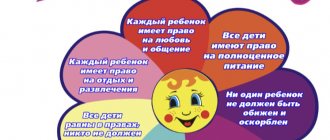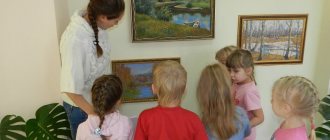Download ready-made templates for environmental laptops.
In the lapbook: natural resources, living and inanimate nature, environmental game “What you can and cannot do in nature,” environmental proverbs
Print out a lapbook on the topic “Garbage”
In the lapbook: sorting waste for subsequent recycling, the time frame for decomposition of waste in pictures.
Photos of homemade lapbooks in author’s blogs on the MAAM portal
Contained in sections:
- Lapbook. Lapbooks on all topics 7360
- Garbage. Let's protect nature from garbage 933
- Ecology for children. Ecolates, nature defenders 4127
- Ecology, nature protection. Didactic games and aids 79
Includes sections:
- Red Book. Lapbooks, homemade manuals 46
Showing publications 1-10 of 247. All sections | Ecological lapbooks
New
Photo
The best
Ecological lapbook “Eco-preschool children” for the middle group
[Goal: To convey to children the idea that they need to take care of nature. Objectives: To give children an initial understanding of ecology ; Develop cognitive interest; Expand children's knowledge; Strengthen children's knowledge about animals, plants, trees; Cultivate respectful and...
Double-sided lapbook on ecology “Ecological assortment”
In the modern world, environmental education is becoming one of the priority areas of preschool educational institutions. Its goal is to form a personality capable of caring for nature, living in harmony with it, and being aware of the consequences of their actions in relation to the environment. To…
Lapbook “Take care of nature”
Didactic manual lapbook “Take care of nature!”
Prepared by teacher Sidorenko L.P.
Didactic manual
presented in the form of
a lapbook
“
Take care of nature
”, is an A4 folder, on the pages of the folder there are various pockets, games and cards that contain information on the topic.
Benefit
can be used not only in educational activities and be of a teaching nature, but also in joint activities of an adult with children, in individual and subgroup work, as well as in independent activities of children.
Lapbook
is an amazing handcrafted educational tool.
itself is very interactive
, from the process of its creation to the finished result.
And each component of the lapbook
gives him the opportunity to focus on a specific aspect of a larger topic.
Explanatory note:
Relevance:
The federal state educational standard for preschool education involves the formation of a general culture of children’s personality, including the values of a healthy lifestyle, the development of their social, moral, aesthetic, intellectual, physical qualities, initiative, independence and responsibility of the child, and the formation of prerequisites for educational activities.
Environmental education of children is of great importance in the implementation of this problem. Today, environmental literacy, careful
and a loving attitude towards
nature
have become the key to human survival on our planet.
Environmental education for children has great potential for their comprehensive development. A thoughtful, systematic acquaintance of a child with the natural
allows him to develop the most important operations of thinking: analysis, comparison, the ability to establish relationships, generalization.
Age orientation
: the benefit is intended for children 5 – 7 years old.
Target:
consolidation and formation of the principles of ecological culture:
correct attitude of the child to nature, to the world around him, to himself, to
people as part of nature, to things and natural materials
origins they use. Formation in children
ecological consciousness.
Tasks:
- develop cognitive interest in nature
, logical thinking,
cognitive - research activities, promote
accumulation of environmental knowledge;
- form ideas about system structure nature
;
- cultivate conscious, caring and respect for nature
;
- develop interest and love for nature.
Lapbook contents
involves the use of a variety of methods in working with it: visual (examination of illustrations), verbal (conversations, reading fiction about
nature
), practical
(ecological games, rules of conduct in nature )
.
The problem, based on the requirements of the Federal State Educational Standard for Education, has significantly changed the approach to organizing educational activities. A modern child needs not so much to know a lot, but to think consistently and convincingly, and to show mental effort. In this regard, teachers are faced with the task of finding new non-standard forms of interaction with students. Traditional education is being replaced by productive learning, which is aimed at developing creative abilities
, formation of interest in creative activities among preschoolers.
Ultimately, all the tasks of the didactic manual
are aimed at achieving a single goal - a conscious attitude of children towards
nature
, forming in them the foundations of environmental consciousness.
Contents of the teaching aid
:
- "Puzzles" -
development of logical thinking, knowledge about the natural world.
- "Animals of Reservoirs"
— formation of primary ideas about the inhabitants of various reservoirs.
- “Know and remember! Save water!
— teach children to save water. To consolidate knowledge of basic rules for handling water resources.
- "Living and inanimate nature"
— generalize children’s knowledge about living and inanimate nature, promote the development of cognitive interests.
- "Nature in Danger"
— Introduce people to the rules of behavior in nature and the possible dangers that may lurk if these rules are not followed.
- "Ecological signs"
- consolidate the rules of behavior in nature.
- "Green Pharmacy"
- generalize children’s knowledge about plants that have a medicinal effect for humans.
- "Red Book of the Orenburg Region"
— give the concept of the Red Book: study of rare species that are listed in the Red Book. Introduce us to the plants and animals found in the area in which we live.
- "Rebuses"
- developing the ability to solve logical problems about the natural world around us.
- "Check yourself
.
Collect and guess
” - development of attention, logical thinking. - “Whose traces?”
-
recognize famous animals by their footprints,
match the picture with the image of the footprint to the picture of the corresponding
animal, name animals correctly.
- "Fairy tales. Poetry. Stories" -
Expand horizons, introduce the world that surrounds the child.
- “Stages of development of the animal world” -
expand ideas about the growth and development of animals and plants, be able to distinguish between stages and paths of development, and develop logical thinking.
- “Structure diagrams of animals and plants” -
expand your understanding
of
the structure of animals and plants. - "Garbage sorting"
- a sorting task, to consolidate the knowledge of what is made of what.
In the manual
we consider the environmental issue
“Garbage Sorting”, in it we consider the questions: “Where does it come from?
garbage
?”, “Where does he go?”, “What happens to him?” and "How can we
help nature
" etc
The manual is multifunctional, transformable, mobile, convenient for both children and teachers. The material is selected taking into account the individual and age characteristics of children.
Conclusions:
The implementation of this benefit brings all children and the teacher closer together. Children's horizons broaden and their mental activity improves. Brings the teacher a replenishment of the subject-development environment in the form of a series of exclusive interactive folders about nature.
As a result of the implementation of the manual, the hypothesis was confirmed that a lapbook is an excellent way to obtain, expand and consolidate knowledge on a certain topic.
The value of a lapbook for preschoolers:
-promotes understanding and memorization of information on the topic;
-promotes the child’s acquisition of skills for independently collecting and organizing information on a topic;
-promotes repetition and consolidation of material on the topic.
Conclusion
. The manual is aimed at solving environmental problems. The content of the lapbook helps to expand environmental understanding and consolidate concepts on the topic “Ecology. Protect the environment!". While working with thematic material, the child conducts observations, completes tasks, studies and consolidates information. Subsequently, having a ready-made thematic folder at hand, the child can refresh his knowledge on a particular topic.
Ecological lapbooks – Lapbook “Butterflies” in environmental education for preschool children
Publication “Lapbook “Butterflies” in environmental education...”
In accordance with the requirements of the Federal State Educational Standard for Educational Education, new requirements also appear for the organization of work with children. To make the process of environmental education of preschoolers interesting, it is important to search for new innovative technologies. In the methodological literature you can find a description...
Image library "MAAM-pictures"
Lapbook on environmental education through didactic games
Didactic games are considered one of the most effective means of teaching and developing preschoolers. Didactic games of ecological content help to see the integrity of an individual organism and ecosystem, to realize the uniqueness of each natural object, to understand that unreasonable...
Lapbook “Take care of nature”
Methodological manual - LAPTOP Direction - Environmental education Age group - school preparatory group (5-7 years old) The topic of the lapbook - “Take care of nature” The lapbook, as a form of organizing educational activities, helps to better understand and remember the material according to a given...
Exhibition of lapbooks in the junior group “Ecological Assortment”
It has long been no secret to people that on Earth various species of animals and plants are disappearing at a tremendous speed, and the environment is becoming increasingly polluted. To prevent an environmental disaster, we, teachers and parents, must cultivate an environmental culture from an early age. IN…
Types of lapbooks
How to make a pumpkin for Halloween with your own hands 2021: step by step photos
Fabulous. Plays out your favorite fairy tale or cartoon. The image of your favorite hero allows you to play with him, play out any situations or scenes.
Thematic. Contains fairy tales, poems, songs, riddles, proverbs and sayings, rhymes, pictures on the topic.
School. They help in mastering certain school material and prepare for tests.
Preschool. They develop imagination and creativity, cognitive and research activities, help the development of memory, speech, communication skills, etc.
Encyclopedic. Information is presented in a structure similar to an encyclopedia.





